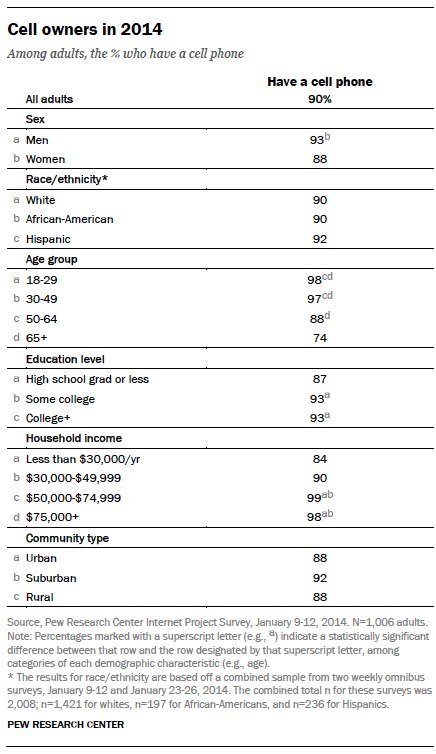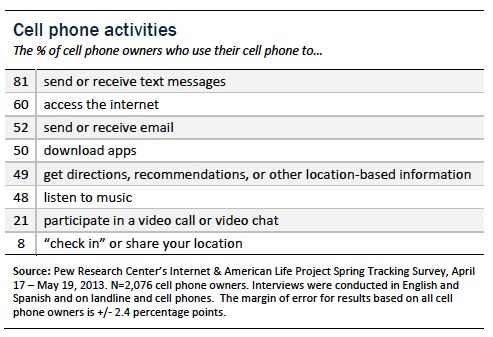Highlights of the Pew Internet Project’s research related to mobile technology.
[source: Pew Research Center] As of October 2014:
64% of American adults own a smartphone.
As of January 2014:
- 90% of American adults own a cell phone
- 32% of American adults own an e-reader
- 42% of American adults own a tablet computer
Some smartphone owners — particularly younger adults, minorities and lower-income Americans — depend on their smartphone for Internet access. Of U.S. adults who own a smartphone, 7% are “smartphone-dependent.”
For more information on U.S. smartphone ownership, visit this in-depth report.
- 67% of cell owners find themselves checking their phone for messages, alerts, or calls — even when they don’t notice their phone ringing or vibrating.
- 44% of cell owners have slept with their phone next to their bed because they wanted to make sure they didn’t miss any calls, text messages, or other updates during the night.
- 29% of cell owners describe their cell phone as “something they can’t imagine living without.”
(Above info based on April 2012 data.)
The demographic breakdown of cell and smartphone owners (January 2014):

Cell Internet access:
As of May 2013, 63% of adult cell owners use their phones to go online.
- 34% of cell Internet users go online mostly using their phones, and not using some other device such as a desktop or laptop computer.
How Americans use their cell phones (activities):

See: Pew Internet Cell Activities Report
Location:
74% of adult smartphone owners ages 18 and older say they use their phone to get directions or other information based on their current location.
Among adult social media users ages 18 and older, 30% say that at least one of their accounts is currently set up to include their location in their posts.
12% of adult smartphone owners say they use a geosocial service to “check in” to certain locations or share their location with friends, down from 18% in early 2012.
Among these geosocial service users, 39% say they check into places on Facebook, 18% say they use Foursquare, and 14% say they use Google Plus, among other services.
Mobile phone problems:
In April 2012, we found:
- 72% of cell owners experience dropped calls at least occasionally. Some 32% of cell owners say they encounter this problem at least a few times a week or more frequently than that.
- 68% of cell owners receive unwanted sales or marketing calls at one time or another. And 25% of cell owners encounter this problem at least a few times a week or more frequently.
Some 79% of cell phone owners say they use text messaging on their cells. We asked them if they got spam or unwanted texts:
- 69% of those who are texters say they get unwanted spam or text messages. Of those texters, 25% face problems with spam/unwanted texts at least weekly.
Some 55% of cell phone owners say they use their phones to go online — to browse the Internet, exchange emails, or download apps. We asked them if they experience slow download speeds that prevent things from loading as quickly as they would like:
- 77% of cell Internet users say they experience slow download speeds that prevent things from loading as quickly as they would like. Of those cell Internet users, 46% face slow download speeds weekly or more frequently.
“Just in time” information:
An April 2012 survey finds that some 70% of all cell phone owners and 86% of smartphone owners have used their phones in the previous 30 days to perform at least one of the following activities:
- Coordinate a meeting or get-together — 41% of cell phone owners have done this in the past 30 days.
- Solve an unexpected problem that they or someone else had encountered — 35% have used their phones to do this in the past 30 days.
- Decide whether to visit a business, such as a restaurant — 30% have used their phone to do this in the past 30 days.
Find information to help settle an argument they were having — 27% haveused their phone to get information for that reason in the past 30 days. - Look up a score of a sporting event — 23% have used their phone to do that in the past 30 days.
- Get up-to-the-minute traffic or public transit information to find the fastest way to get somewhere — 20% have used their phone to get that kind of information in the past 30 days.
- Get help in an emergency situation — 19% have used their phone to do that in the past 30 days.
Overall, these “just-in-time” cell users — defined as anyone who has done one or more of the above activities using their phone in the preceding 30 days—amount to 62% of the entire adult population.
Privacy:
- More than half of app users have uninstalled or decided to not install an app due to concerns about their personal information.
- One in five cell owners have turned off the location tracking feature on their phone, and one in three have cleared their cell phone browsing or search history
More information on privacy and data management on mobile devices can be found at http://www.pewinternet.org/2012/09/05/privacy-and-data-management-on-mobile-devices/
9% of adults have texted a charitable donation from their mobile phone. Mobile giving played an especially prominent role during the aftermath of the January 2010 Haiti earthquake, as individual donors contributed an estimated $43 million to the assistance and reconstruction efforts using the text messaging feature on their cell phones:
- The first-ever, in-depth study on mobile donors — which analyzed the “Text to Haiti” campaign after the 2010 earthquake — finds that these contributions were often spur-of-the-moment decisions that spread virally through friend networks.
- 74% of Haiti text donors say that their donation to the Haiti earthquake relief was the first time they had used their phone’s text messaging function to make a donation to an event, cause or organization.
- 22% had texted a donation of some kind prior to their contribution to Haiti earthquake relief
